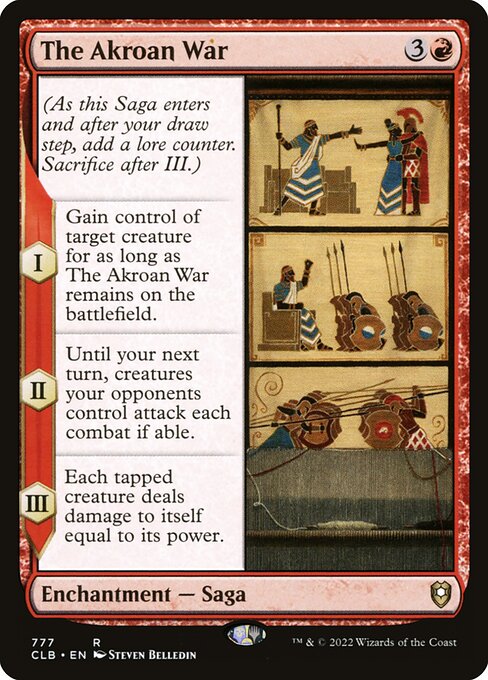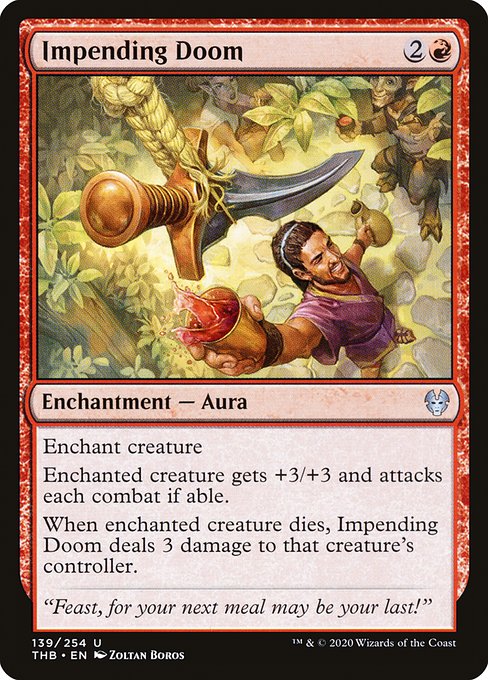Original Theros was marked by a dearth of removal. The supported strategy in the set was to load up a creature with Auras and Bestow creatures, so non-situational removal was pretty much limited to Divine Verdict, Lash of the Whip, Sip of Hemlock, Lightning Strike, and Rage of Purphoros. Voyage’s End became premium interaction.
New Theros doesn’t have Heroic or the all-in Bogles strategy, and so the removal is absurd. Black gets the cerberus’s share, with Mire’s Grasp, Final Death, Drag to the Underworld, and Mogis’s Favor at lower rarities and Erebos’s Intervention and Eat to Extinction at rare; but White’s no slouch, either.
A Note on Mire’s Grasp
What looks like a simple sorcery speed Last Gasp is actually a recurrable and reliable first pick. With Rise to Glory, you’re going to be able to buy this back, and it can even shrink Gods once they’re active. Between Dreadful Apathy, Heliod’s Punishment, Inevitable End, and Mire’s Grasp, Hateful Eidolon is going to be a legitimate strategy in a black-white deck. The white enchantments don’t exactly lead to their targets dying, but Heliod’s Pilgrim ties the archetype together. The color pair in Theros was fun to draft: pick up early Gray Merchants (then at common), a Sentry of the Underworld, any removal you saw, and grind it out. I still have fond memories of my Two-Headed Giant team’s triple-Scholar of Athreos deck, and the judge calls it engendered. “Wait, it’s both players!?” was a common sentence. As a long-time Orzhov mage/follower of Athreos/Kaya partisan, I’m looking forward to drafting the white/black enchantment deck.
Beyond Death has more than twice the number of enchantments as original Theros—95 to 41, to be precise—and so enchantment synergy will be easier than in the original block (especially since Constellation took until the third set to appear). This, of course, means that enchantment removal climbs up the pick order—Artisan’s Sorrow was always a useful card, but now that enchantments can be game-winning bombs in addition to Heroic targets, Mystic Repeal starts looking an awful lot like Murder, rather than Disenchant.
There’s a metatextual tie-in to original Theros, where you could, if you drafted improperly, wind up with more Auras than targets and a clunky Bestow chain instead of a curve. I tended to default to Minotaurs to avoid this pitfall; but sadly, the herd didn’t show up in force this go-round. That said, the red-black sacrifice deck looks like a blast if it comes together, with Anax, Hardened in the Forge as the build-around that makes it possible. Lampad of Death’s Vigil does some work here, and is another good target for Return to Nature and friends.
Where Do You Think You’re Going?
Escape is going to be way, way better than it reads on paper, as I imagine we all learned this weekend at the Prerelease. Flashback was a subtle powerhouse back in Odyssey, giving players implicit card advantage, but was panned as too expensive during initial previews. Even in Innistrad, I recall reading how Silent Departure was too pricey to rely upon, only for it to overperform.
There’s a balance that needs to be struck with Escape cards; but being able to buy something back from the graveyard is inherently powerful, and to do so multiple times per game even more so. Unlike Flashback, where you weren’t punished for maxing out on Flashback cards, you can’t play many Escape cards—I have my eye more on the Constellation-triggering Auras than on the value cards like Chainweb Arachnir. More than anything, I love the tension in Theros Beyond Death—the Escape cards require a subtheme of graveyard exile, and that balancing act results in the set feeling more like an actual war mechanically and flavorfully.
Contrast that mechanical tension to something like Aether Revolt, which didn’t nail the vibe of competing factions; and you start to see how a conflict that plays itself out in the flavor of the cards takes on greater import when you play through the conflict every game. It’s beautiful design, and I’d suggest taking cards like Incendiary Oracle sooner than you would in, say, Dominaria. As a fan of entropy, cosmic horror, Francisco Goya, and trying to make Blightning work in every single format; I absolutely love Kroxa, Titan of Death’s Hunger, and mourn Faithless Looting’s ban.
Symbol Mindfulness

The Akroan War is my favorite card from the set—it perfectly captures both the ferocity and the futility of war. (The artwork also sold for a lot of money.) You rapture someone, which launches a war; eventually the besieging army is so exhausted and demoralized that they lay down and die. Certainly no blatant parallels to anything in the real world to be found here; this is a children’s card game, after all. I’ve praised Sagas before, and I’m thrilled to see them return so quickly and evocatively.

I also love Impending Doom. It’s a riff on the legend, as recounted by Cicero, in which a bootlicker named Damocles swaps places with a king, who hangs a sword suspended by a single hair above his head. Damocles can enjoy all the pleasures of a king, but must live with the mortal peril of monarchy. Personally, as someone who sees the mortal peril everyday people labor under, while believing that a different sort of blade should hang over the heads of kings, I’ve never found it an especially relevant lesson, although it’s a useful enough allusion.
Weak-Armed Tropism
Speaking of allusions, let’s close with a brief note on Homeric epithets: in The Iliad and The Odyssey, Homer deploys a characteristic descriptive device, wherein he drops an often-hyphenated descriptor for a character, e.g., “white-armed Athena,” “swift-footed Achilles,” etc. Harkening back to Homer, the flavor writers for Theros included this device; unfortunately, they drastically overdid it. The Homeric epithet is used in the set as variously as in The Callaphea, Theros’s answer to Homer’s work (fair enough), the speech of a gorgon (Venomous Hierophant), the words of a poet (Alseid of Life’s Bounty, Oread of Mountain’s Blaze), and The Cosmogeny.
Thing is, these epic poems were designed to be an oral medium; what could be descriptive and eloquent in speech is distracting and clunky in text. Contrast Theros: Beyond Death’s frankly insipid epithets to Madeline Miller’s Circe or The Song of Achilles, books that understand that duplication of classic tropes only diminishes their impact. Myths are designed to be adapted, not to be mimicked. That’s the new set’s only real failure, as far as I’m concerned; but it turns what could have been a clever allusion into tone-deaf and distracting writing—ironic for a world based around divine inspiration and legendary deeds.
Naming the Gods as “X, Epithet” would have been a nice touch, as it directly mirrors Homer’s descriptions of the gods; larding it into flavor text turns it from a clever reference into a clanging repetition. That mirroring, though, is part of the point. Theros Beyond Death, as a set, is a beautifully-designed reflection of the original block; with Escape serving as a fated late-game mana sink, similar to Monstrosity; and Sagas mechanically and contextually tying the set’s flavor and themes together. Old heroes and gods return, in some cases from the dead; the themes of divine war and destiny are carried not by prolix flavor text, but in the way the games play out. That’s the great success of the set—not the way it feels like a return to Theros, but in the way it feels like a return to myth.
A lifelong resident of the Carolinas and a graduate of the University of North Carolina, Rob has played Magic since he picked a Darkling Stalker up off the soccer field at summer camp. He works for nonprofits as an educational strategies developer and, in his off-hours, enjoys writing fiction, playing games, and exploring new beers.
This article contains referral links from which Hipsters of the Coast may make a commission.

